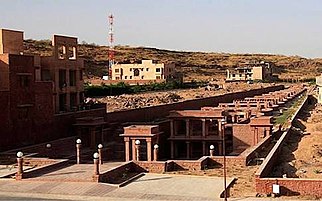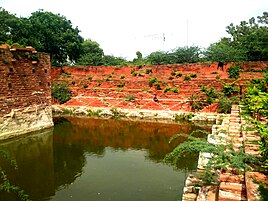Stepwell



Stepwells are wells or ponds in which the water is reached by descending a set of steps to the water level. They may be multi-storeyed with a bullock turning a water wheel to raise the well water to the first or second floor. They are most common in western India and are also found in the other more arid regions of the Indian subcontinent, extending into Pakistan. The construction of stepwells is mainly utilitarian, though they may include embellishments of architectural significance, and be temple tanks.
Stepwells are examples of the many types of storage and irrigation tanks that were developed in India, mainly to cope with seasonal fluctuations in water availability. A basic difference between stepwells on the one hand, and tanks and wells on the other, is that stepwells make it easier for people to reach the groundwater and to maintain and manage the well.
The builders dug deep trenches into the earth for dependable, year-round groundwater. They lined the walls of these trenches with blocks of stone, without mortar, and created stairs leading down to the water.[1] The majority of surviving stepwells originally served a leisure purpose as well as providing water. This was because the base of the well provided relief from the daytime heat, and this was increased if the well was covered. Stepwells also served as a place for social gatherings and religious ceremonies. Usually, women were more associated with these wells because they were the ones who collected the water. Also, it was they who prayed and offered gifts to the goddess of the well for her blessings.[1] This led to the building of some significant ornamental and architectural features, often associated with dwellings and in urban areas. It also ensured their survival as monuments.
Stepwells usually consist of two parts: a vertical shaft from which water is drawn and the surrounding inclined subterranean passageways, chambers and steps which provide access to the well. The galleries and chambers surrounding these wells were often carved profusely with elaborate detail and became cool, quiet retreats during the hot summers.[2]
Names[]
A number of distinct names, sometimes local, exist for stepwells. In Hindi-speaking regions, they include names based on baudi (including bawdi (Rajasthani: बावड़ी), bawri, baoli, bavadi, and bavdi). In Gujarati and Marwari language, they are usually called vav or vaav (Gujarati: વાવ). Other names include kalyani or pushkarani (Kannada), baoli (Hindi: बावली) and barav (Marathi: बारव).
History[]

The stepwell may have originated to ensure water during periods of drought. The earliest archaeological evidence of wells provided with steps to reach them is found at Dholavira while the site also has water tanks or reservoirs which are also provided with flights of steps. Mohenjo Daro's great bath is also provided with steps on opposite directions. Ashokan inscriptions mention construction of step wells along major Indian roads at a distance of every 8 kos for the convenience of travellers, but Ashoka states that it was a well established practice which predated him and was done by former kings as well.
King Devanampriya Priyadarsin speaks thus. On the roads banyan-trees were caused to be planted by me, (in order that) they might afford shade to cattle and men, (and) mango-groves were caused to be planted. And (at intervals) of eight kos wells were caused to be dug by me, and flights of steps (for descending into the water) were caused to be built. Numerous drinking-places were caused to be established by me, here and there, for the enjoyment of cattle and men. [But] this so-called enjoyment (is) [of little consequence]. For with various comforts have the people been blessed both by former kings and by myself. But by me this has been done for the following purpose: that they might conform to that practice of morality.
— Ashokan Pillar Edict No 7
The first rock-cut stepwells in India date from 200-400 AD.[3] The earliest example of a bath-like pond reached by steps is found at Uperkot caves in Junagadh. These caves are dated to the 4th century. Navghan Kuvo, a well with the circular staircase in the vicinity, is another example. It was possibly built in Western Satrap (200-400 AD) or Maitraka (600-700 AD) period, though some place it as late as the 11th century. The nearby Adi Kadi ni Vav was constructed either in the second half of the 10th century or the 15th century.[4]
The stepwells at in Rajkot district are dated to 550-625 AD. The stepped ponds at Bhinmal (850-950 AD) are followed by it.[3] The stepwells were constructed in the southwestern region of Gujarat around 600 AD; from there they spread north to Rajasthan and subsequently to the north and west India. Initially used as an art form by Hindus, the construction of these stepwells hit its peak during Muslim rule from the 11th to 16th century.[2]
One of the earliest existing example of stepwells was built in the 11th century in Gujarat, the Mata Bhavani's Stepwell. A long flight of steps leads to the water below a sequence of multi-story open pavilions positioned along the east/west axis. The elaborate ornamentation of the columns, brackets and beams are a prime example of how stepwells were used as a form of art.[5]
The Mughal emperors did not disrupt the culture that was practiced in these stepwells and encouraged the building of stepwells. The authorities during the British Raj found the hygiene of the stepwells less than desirable and installed pipe and pump systems to replace their purpose.[5]
Significance[]
The stepwell ensures the availability of water during periods of drought. The stepwells had social, cultural and religious significance.[5] These stepwells were proven to be well-built sturdy structures, after withstanding earthquakes.[1]
Details[]
Many stepwells have ornamentation and details as elaborate as those of Hindu temples. Proportions in relationship to the human body were used in their design, as they were in many other structures in Indian architecture.[6]
Stepped ponds[]

Stepped ponds are very similar to stepwells in terms of purpose. Generally, stepped ponds accompany nearby temples while stepwells are more isolated.[7] Stepwells are dark and barely visible from the surface, while stepped ponds are illuminated by the light from the sun. Stepwells are quite linear in design compared to the rectangular shape of stepped ponds.[6]
In India[]
A number of surviving stepwells can be found across India, including in Rajasthan, Gujarat, Delhi, Madhya Pradesh, Maharashtra, and North Karnataka (Karnataka). In 2016 a collaborative mapping project, Stepwell Atlas,[8] started to map GPS coordinates and collate information on stepwells, mapping over 2800 stepwells in India. Another project mapped the location of over 1300 stepwells in Maharashtra.[9]
In his book Delhi Heritage: Top 10 Baolis, Vikramjit Singh Rooprai mentions that Delhi alone has 32 stepwells.[10] Out of these, 16 are lost, but their locations can be traced. Of the remaining 16, only 14 are accessible to public and the water level in these keeps varying, while two are now permanently dry.
Significant stepwells include:
- Agrasen ki Baoli, New Delhi
- Rajon ki baoli, New Delhi
- Chand Baori in Abhaneri near Jaipur, Rajasthan
- Rani ki vav at Patan, Gujarat
- Adalaj ni Vav at Adalaj, Gandhinagar, Gujarat
- Dada Harir Stepwell, Ahmedbad
- Navghan Kuvo and Adi Kadi vav, Uparkot Fort, Junagadh
- , Jodhpur
- Birkha Bawari, Jodhpur
- , Lucknow
- Raniji ki Baori in Bundi, Rajasthan; Bundi has over 60 baolis in and around the town.
- , Amer, India
- Udoji ki Baori, Mandholi, Rajasthan
- Kalyani, Hulikere
- Bhoga Nandeeshwara Temple, Karnataka
- Sree Peralassery Temple, Kerala[11]
- Charthana Stepwell, Parbhani, Maharashtra
- Pingli Stepwell, Parbhani, Maharashtra
- Arvi Stepwell, Parbhani, Maharashtra
In Pakistan[]

Stepwells from Mughal periods still exist in Pakistan. Some are in preserved conditions while others are not.
- Rohtas Fort, near Jhelum
- Wan Bhachran, near Mianwali
- Losar Baoli, near Islamabad
- Makli Baoli, near Thatta
Influence[]
Stepwells influenced many other structures in Indian architecture, especially those that incorporate water into their design.[2] For example, the Aram Bagh in Agra was the first Mughal garden in India.[6] It was designed by the Mughal emperor Babur and reflected his notion of paradise not only through water and landscaping but also through symmetry by including a reflecting pool in the design. He was inspired by stepwells and felt that one would complement the garden of his palace. Many other Mughal gardens include reflecting pools to enhance the landscape or serving as an elegant entrance. Other notable gardens in India which incorporate water into their design include:
- Humayun's Tomb, Nizamuddin East, Delhi
- Taj Mahal, Agra
- Mehtab Bagh, Agra
- Safdarjung's Tomb
- Shalimar Bagh (Srinagar), Jammu and Kashmir
- Nishat Gardens, Jammu and Kashmir
- Yadvindra Gardens, Pinjore
- Khusro Bagh, Allahabad
- Roshanara Bagh
Gallery[]

Large stepwell at Nagnath Mandir in Hatnoor Village, Parbhani District in Maharashtra

View of a stepwell at Fatehpur, Shekhawati

The 18th-century Baoli Ghaus Ali Shah, in Farrukhnagar, Haryana

Birkha Bawari, a stepwell at Jodhpur

Rudabai stepwell or Adalaj ni Vav at Adalaj, Gandhinagar, Gujarat

Toor Ji Ki Bawari, stepped well, Jodhpur

Stepped well, Hampi

Jachcha Ki Baori in Hindaun, Rajasthan
See also[]
- Check dam
- Ghat
- History of stepwells in Gujarat
- Johad
- Liman
- Subak (irrigation)
- Taanka
- Tube well
- Water well
Notes[]
- ^ Jump up to: a b c Shekhawat, Abhilash. "Stepwells of Gujarat". India's Invitation. Retrieved 30 March 2012.
- ^ Jump up to: a b c Davies, Philip (1989). The Penguin guide to the monuments of India. London: Viking. ISBN 0-14-008425-8.
- ^ Jump up to: a b Livingston & Beach, page xxiii
- ^ Jutta Jain-Neubauer (1981). The Stepwells of Gujarat: In Art-historical Perspective. Abhinav Publications. pp. 19–25. ISBN 978-0-391-02284-3.
- ^ Jump up to: a b c Tadgell, Christopher (1990). The History of Architecture in India. London: Phaidon Press. ISBN 0-7148-2960-9.
- ^ Jump up to: a b c Livingston, Morna (2002). Steps to Water: The Ancient Stepwells of India. New York: Princeton Architectural. ISBN 1-56898-324-7.
- ^ Jain-Neubauer, Jutta (1981). The Stepwells of Gujarat: In art-historical Perspective. New Delhi: Abhinav. ISBN 0-391-02284-9.
- ^ Stepwell Atlas
- ^ "Maharashtra Stepwells". Maharashtra Stepwells. Retrieved 23 March 2021.
- ^ Rooprai, Vikramjit Singh (2019). Delhi heritage : Top 10 baolis. Niyogi Books. ISBN 9-38913-611-3.
- ^ Sengar, Resham. "Sri Subramanya Temple in Peralassery - its legend, the stepwell and resident snakes". Times of India Travel. Retrieved 2020-03-10.
References[]
- Rima Hooja: "Channeling Nature: Hydraulics, Traditional Knowledge Systems, And Water Resource Management in India – A Historical Perspective". At infinityfoundation.com
- Livingston, Morna & Beach, Milo (2002). Steps to Water: The Ancient Stepwells of India. Princeton Architectural Press. ISBN 1-56898-324-7.
- Vikramjit Singh Rooprai. Delhi Heritage: Top 10 Baolis (2019). Niyogi Books. ISBN 9-38913-611-3.
- Jutta Jain Neubauer The Stepwells of Gujarat: An art-historical Perspective (2001)
- Philip Davies, The Penguin guide to the monuments of India, Vol II (London: Viking, 1989)
- Christopher Tadgell, The History of Architecture in India (London: Phaidon Press, 1990)
- Abhilash Shekhawat, "Stepwells of Gujarat." India's Invitation. 2010. Web. 29 March 2012.<http://www.indiasinvitation.com/stepwells_of_gujarat/>.
- Stepwells in India at Curlie
- "Architecture of the Indian Subcontinent - glossary". Indoarch.org. Retrieved 2006-12-18.
External links[]
| Wikimedia Commons has media related to Stepwells. |
- Irrigation
- Rajasthani architecture
- Water wells
- Buildings and structures in Gujarat
- Stepwells in India
- Architecture of India
- Architecture of Pakistan
- Ponds
- Subterranean structures









